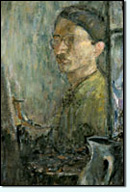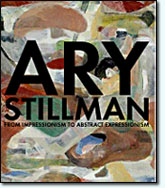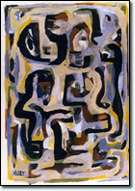Publications
Foundation Brochure
The following paragraphs might be called notes on the development of a painter, but in some ways this statement would give a false picture because Ary Stillman was always a master painter. Of course one realizes that he did not emerge fully armed from the brow of Zeus as did Athena, that there were periods of study which led to mastery, and other early periods when necessity forced an abandonment of painting, but the dedication to it was never lost and the technical mastery which gave meaning was ever present.
Several facts about his early life seem significant to the full understanding of his art. He was born February 13, 1891, in a little village near the town of Slutzk, which is in White Russia not far from the better known city of Minsk. As a child he would cut out designs from rough paper and fill in the designs with scraps of colored paper. What was produced was in effect a collage of abstract shapes of different colors. His talent in color and design was recognized by his school at Slutzk so that when he was in his teens a purse was made up in order that he could study at the Art School of Vilna. Today we would say that he received a scholarship.
However his studies were short-lived, for in 1907 the family decided to immigrate to the United States and settled in Sioux City, Iowa.
It wasn't until after the 1st World War in 1919 that Stillman could give himself wholeheartedly to painting. He left the Midwest and went to New York where he studied for two years, and then in 1921 he went to Paris, which became his home for twelve years and which in a sense marks his emergence as an independent painter. He did not spend all of his time in Paris but traveled through Western Europe and got as far as the Near East and Northern Africa. During this time he was not only studying the art of the various lands but carefully observing the art of what we have come to call the old masters. His only formal training in the twelve years in Europe was a short period of study under Andre L'Hote. In 1928 he had his first one-man show in Paris, a start on a long line of exhibitions.
During these Paris years, broken by one brief visit to the United States, his work was largely objective, but a careful study of his early canvases will show a definite preoccupation with the abstract core of his painting, a continued interest in the arrangement of shapes to express a subjective meaning. The more academic nature of what we might call his Parisian period formed the necessary foundation for his later work in abstract design.
When Ary Stillman returned to New York in 1933, he came as an established painter. His paintings were still representational but with a subjectivity which continued to mark his works. He dealt with scenes of the streets, the market places and the parks where the rush of humanity is always visible. But he treated them with a distinctly personal approach, in which the impact to the viewer came from the thoughts and inner feelings of the artist rather than from descriptive realism. Action seemed muted by introspection but expressed in a rich tonality of color in which silvery blues, greys and soft reds played dominant roles. This was the nature of his work when he first exhibited at the Museum of Fine Arts of Houston, but later he seems to have subjugated tonality to form. Although tonality is never lost, his painting becomes more vigorous, his colors clearer and more vibrant. However it is clearly evident that the artist is not concerned with superficial aspects but with the deeper inner content of his subject.
Perhaps this is one of the reasons that we find him turning gradually to abstraction and to non-objective forms. In any event by the close of World War II Ary Stillman finds himself in a self-created world of abstract forms in which he will remain until his death. Forms which follow his mood, at times gay, at others solemn, but always searching for a visible expression of the reality of life.
Of the last twelve years of his life, eighteen months were spent in a return visit to Paris and to Majorca and later, five years in Mexico. To say that he was unresponsive to the work of the great pre-Cortez civilizations of the Mexican plateau would be a misstatement. The impact of their abstract forms seems to have been a profound one. Not in imitation, for Ary Stillman was never an imitator, but in a subtle confirmation of a point of view. His last works, done in Houston, bear this out as well as they point to a continuous devotion to an ideal. One sees in them the end product of the little boy who cut shapes from rough paper and with the help of colored paper and an inner vision made them into works of art.
The paintings gathered together in Ary Stillman's home in Houston, Texas, are his legacy to mankind. They are more than a group of paintings, for in them one can see the continuous effort of a man at once an idealist and individualist, uncompromisingly dedicated to painting as the means of making evident the meaning and spirit of life.
James Chillman, Jr.
Director Emeritus Museum of Fine Arts of Houston
"In Europe I began a thorough study of the old masters and became particularly interested in the work of the old Sienese masters. I was impressed by the spiritual force that emanates from their work. The more I studied these old masters the more I recognized a monumental quality in all the great works which have survived through the ages, a quality that is the result of their underlying construction and crystallized vision. The greatest factor, I found, which evolves from continuous close contact with great works of art is that our vision is purified. We get to be less conscious of the vulgarity of things. Even the ugly becomes surrounded by a certain charm. My efforts have been along these paths, to discover an approach of my own in the light of the best that has gone before."
Ary Stillman, 1934
"My work is based upon relationship of realities. I love to watch people moving crowds fascinate me, play of light and the drama of life excite me to paint and to try to recreate in moving design the crystallization of the things seen. I don't study the individuals particularly, it is only how they melt into the crowd . . . I use a subdued palette and I refrain from theatrical effects. I strive through accumulated knowledge to reach an ease of intuitive expression."
Ary Stillman, 1940
"I feel that in this present day, reality is no longer the thing we see, it is something we sense…
… therefore I seek an 'inner reality' rather than a 'surface reality' and my paintings are the result of an intuitive approach rather than a conscious planning. Each painting is a different experience, just as each of our dreams is different."
"I have always been a romanticist and I still am. But in this highly industrialized era the sensitive creative artist who has a feeling for the romantic searches for a form of expression without depending on the reality, which is on the surface. Consequently, he looks within himself and eventually a romanticism is born which has evolved from an inner reality rather than a surface reality."
"We used to have a romantic feeling for the place where we were born - the tree which stood by the house--the dog--the cat--the grandfather smoking his pipe. All became part of the romantic scene."
"During World War II and in the years following, our vision of reality has undergone a vast change. The atom, the aeroplane, the radio, the television have practically revolutionized this vision. And with the development of speed, the attachment to places is not so strong. However, the urge of romanticism is still strong. When you can have breakfast in New York, lunch in England, dinner in Egypt, it will be the vista from the plane -the impression of the people you will see- the sensation of movement, of color, of sound, that will be blended to make up the new romantic feeling. All these things will crystallize into something that will be the source of a new poetry and a new vision in the future of art."
Ary Stillman, 1950
"The more I gave myself up to reflection, the more I sensed that my direction must be toward that dream world that dream reality, which is not a conventional reality and not a surrealistic reality. What it was I could not determine, but it was the direction in which I must search. I must lose myself in this dream world, and the techniques, which I had developed over the years, must serve to synchronize my hand and my emotions so that I might bring my day-dreams to full expression.
"Then came the period when I began to play with charcoal on paper. I felt that perhaps accidentally or through a subconscious movement I would get something from within myself. After awhile I discovered that the charcoal drawings opened up for me a direction where I could jump over the fence. I began to feel more and more possibilities of expression."
Ary Stillman, 1952
"Years before my going to live in Mexico I had completely broken away from surface realities. But it was in Mexico that the inner reality began more and more to emerge, that I felt more and more its essence. It was for me a period when fantasy became paintable, or when I invaded the world of fantasy. I was completely involved in the mysticism of the subconscious. This mysticism is the inner thing which gives the spark of imagination."
Ary Stillman, 1965
Copyright © 2002-2007 The Stillman-Lack Foundation.
All text and images on this site may not be published, broadcast, or distributed in any form without the prior written permission of The Stillman-Lack Foundation.









